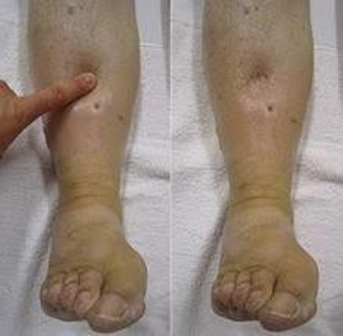The nurse enters the patient's room and the patient states, "I think my feet are swollen.". Which would be the nurse's next action?
The nurse applies pressure over a bony prominence of the foot for 2 seconds.
The nurse percusses the tissue that appears edematous
The nurse elevates the patient's feet on a pillow to decease swelling.
The nurse charts, "Patient's feet appear to be swollen."
The Correct Answer is A
A: Applying pressure over a bony prominence helps assess for pitting edema, a common indicator of fluid retention causing swelling. This action provides objective data to confirm the patient's subjective observation.
B: Percussion is not typically used to assess edema. It is more suitable for assessing the density of underlying structures.
C: Elevating the feet may help alleviate swelling but does not confirm the presence of edema.
D: Documenting the observation is important, but further assessment is needed to confirm the patient's concern.

Nursing Test Bank
Naxlex Comprehensive Predictor Exams
Related Questions
Correct Answer is A
Explanation
A: To accurately determine a pulse deficit, one nurse must listen to the apical pulse while another nurse palpates the radial pulse simultaneously to compare both pulse rates, necessitating a second person.
B: Counting the apical pulse is a part of the process but would follow after ensuring another nurse is available to check the radial pulse at the same time.
C: This action relates to checking a pulse rate generally but does not specify the need for simultaneous comparison with the apical pulse.
D: Calculation of the difference is the final step after both pulses have been counted simultaneously.
Correct Answer is D
Explanation
A: Bradycardia is typically not associated with acute pain; instead, pain usually triggers a sympathetic response, leading to tachycardia.
B: Hypoglycemia has no direct correlation with acute pain levels.
C: Pain tends to increase, not decrease, the respiratory rate due to stress and increased metabolic demand.
D: Acute pain can lead to elevated blood pressure as part of the body's stress response, which includes activation of the sympathetic nervous system.
Whether you are a student looking to ace your exams or a practicing nurse seeking to enhance your expertise , our nursing education contents will empower you with the confidence and competence to make a difference in the lives of patients and become a respected leader in the healthcare field.
Visit Naxlex, invest in your future and unlock endless possibilities with our unparalleled nursing education contents today
Report Wrong Answer on the Current Question
Do you disagree with the answer? If yes, what is your expected answer? Explain.
Kindly be descriptive with the issue you are facing.
